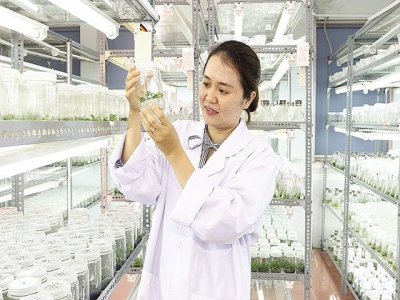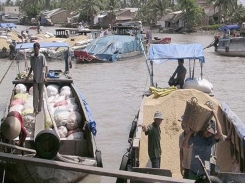GVCs in reach thanks to agricultural investment

Over the past few years, the Vietnamese agricultural sector has gradually climbed global value chains via improvements in product quality based on modern technology. However, much remains to be done for the sector to reduce its raw material exports. Thanh Dat reports.
Vietnam’s agricultural sector has been attracting many high-tech investments helping it join global value chains - Photo: Le Toan
Locally-owned Phuc Sinh Corporation, which exports assorted types of crops such as coffee, pepper, cashews, coconut, and rice, has been exporting its K-Coffee products to the EU and North America. It is the sole coffee product in Vietnam featuring the tagline “100 per cent pure roasted coffee.”
Last year, the company’s revenue growth from K-Coffee for domestic consumption and export reached double digits, and this is expected to remain the case this year. So as to ensure the highest quality coffee, the company has been applying the world’s best standards to production, including UTZ Certified the EU and the US, and Britain’s BRC Global. The UTZ Certified label is featured on more than 10,000 different product packages in over 116 countries. Meanwhile, BRC Global Standards is a leading brand and consumer protection organisation, used by over 26,000 certificated suppliers over 130 countries.
“We have been co-operating with farmers for production, and applying these standards to the coffee farms,” the company’s chairman and general director Pham Minh Thong told VIR. “We want Vietnamese coffee to be ranked on top of the world in terms of quality, and establish a firm niche in global value chains (GVCs).”
Currently, the firm is co-operating with nearly 900 coffee households over 1,000 hectares under UTZ standards, with total annual output of nearly 2,750 tonnes. Phuc Sinh’s total export turnover was estimated to be about $280 million last year, far higher than the $200 million in 2017, but lower than the $300 million of the previous year.
According to the Ministry of Agriculture and Rural Development (MARD), the country’s total agro-forestry-fishery export turnover hit $40.02 billion last year, with over $20 billion worth of crop staples, up from nearly $19 billion in 2017.
A new trend
Vietnam has progressed to become the world’s fifth-largest exporter of agro-food commodities including aquatic products, rice, coffee, tea, cashew, black pepper, rubber, and cassava.
In the chase to earn high profits, many domestic and overseas companies have been deploying high-tech agricultural projects in Vietnam in recent years.
According to the MARD, the rise in export turnover of farm produce is ascribed to an increase in productivity and output facilitated by more hi-tech methods being applied.
“Domestic crop products are being exported in higher numbers, with more quality, meaning that they are gradually climbing up GVCs,” said Minister of Agriculture and Rural Development Nguyen Xuan Cuong. “More and more foreign companies want to introduce high technology to the local agricultural sector.”
David Traub, director of Germany’s B.K Smart Agro Company, told VIR that he will visit Vietnam this year to seek partners to supply tech to supervise tractors, sowers, and the quality of plants.
In October last year, Traub arrived in the country for the same purpose, and landed contracts with five Vietnamese partners.
While overseas, Traub simply uses his mobile phone to directly check how his tractors and sowers are performing on his family’s eight-hectare wheat plot in Nürtingen, a town in southern Germany. The land is used by the company to test the technology it creates.
“This tech can help improve product quality and enable exporters in Vietnam to export high-quality products, and earn more money,” he said.
In another case Pham Hoang Ngan, co-ordinator in Vietnam of Mekong Agritech Challenge, a programme of the Mekong Business Initiative, said that many foreign firms also want to apply their IT solutions in Vietnam’s agricultural sector. Firms include Gintel from Taiwan, China’s GAGO Ltd., Enzootic Ltd. from Hong Kong and Israel, FairAgora from Thailand, Pycno Industries from Australia, and India’s Intello Labs Pvt., Ltd.
“They offer a raft of platforms in the format of apps, software, and cell transplantation technology,” said Ngan, who is helping some of these firms enter Vietnam. “Here, local agricultural businesses now tend to use in their production foreign high-tech solutions. This offers big opportunities for these foreign enterprises.”
Thailand’s GoodHout BV is seeking coconut processors, coconut husk suppliers, and wood panel and furniture manufacturers. The firm’s aim is to turn coconut waste into a high-quality bio-based material to sell in the EU.
Bumpy road ahead
According to the World Bank, Vietnam is among the five leading exporters in terms of volume, and also generally in total value.
A report on Vietnamese agriculture recently released by the World Bank says, “However, most of Vietnam’s exports sell at a discount compared to other global leaders. For some commodities, Vietnam’s particular varieties, for example robusta coffee, and lead market position, for instance 25 per cent broken white rice, generally have a lower unit value than alternatives such as arabica coffee, or jasmine rice.”
Vietnam’s average free on board prices, even within these variety categories, tend to be lower than those of peers. For example, Vietnam’s 25 per cent broken rice is sold at a $30-40 discount per tonne compared to the same product from Thailand. Furthermore, Vietnam’s robusta coffee exports are sold at a small discount on the LIFFE international price index.
Currently, the average unit value for Vietnamese tea ($1,524) is about 40 per cent lower than that of India ($2,688) and Kenya ($2,799).
In recent years, there has been some repositioning of the rice trade into higher quality or different variety segments, including for aromatic varieties. “But there too, the Vietnamese product earns a lower price than that of peers,” said the World Bank report.
Much of Vietnam’s large agro-food trade is virtually invisible to the majority of end-users or consumers abroad, with the less expensive raw materials usually blended with those from elsewhere to obtain a finished product.
Vietnam’s low-cost robusta coffee is blended with arabica coffee from Africa or Latin America to produce different brands of instant coffee in Europe and North America. Vietnam’s dried cassava is converted into animal feed, starch, and other products, generally in China. The bulk of Vietnam’s exports of bamboo follow a similar path, along which most of the value-addition occurs overseas. Many of its raw materials are sold in products with labels that confirm it is made with supplies from different countries. Fresh produce may go unlabeled or sometimes even with a label of a different country of origin.
Minister Cuong admitted that although Vietnam is strong in agricultural development, 90 per cent of its farm produce exports are raw or initially processed. “This means their quality and export prices are clearly lower than similar products in other nations,” he said. “This will affect the agricultural sector in its process in joining GVCs.”
According to another World Bank report on Vietnam’s engagement in the next generation of GVCs, the country’s agricultural sector has done an impressive job of entering and then strengthening its participation in GVCs over the last few decades. However, if the sector is to realise its full potential by 2035, critical challenges must be overcome.
To increase opportunities and strengthen participation in GVCs, it will need to continue to foster the absorptive capacity of farmers and agri-processors like Phuc Sinh Corporation, according to the report.
“To raise local farm produce to a higher niche in GVCs, firms should improve their own competitiveness, and prepare for increased competition as the government proceeds with the reduction and eventual elimination of higher agricultural tariffs under current and potential trade agreements,” Thong of Phuc Sinh said.
Related news
Tools

Phối trộn thức ăn chăn nuôi

Pha dung dịch thủy canh

Định mức cho tôm ăn

Phối trộn phân bón NPK

Xác định tỷ lệ tôm sống

Chuyển đổi đơn vị phân bón

Xác định công suất sục khí

Chuyển đổi đơn vị tôm

Tính diện tích nhà kính

Tính thể tích ao



 Vĩnh Long works to increase mango exports to…
Vĩnh Long works to increase mango exports to…  Vietnam second biggest coffee supplier of Belgium in…
Vietnam second biggest coffee supplier of Belgium in…